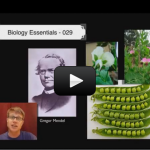Why do families share similar features like eye and hair color? Why aren’t they exact clones of each other? These questions and many more will be answered as well look into the fascinating world of genetics!
Genetics is defined as “the science of heredity , dealing with resemblances and differences of related organisms resulting from the interactions of their genes and the environment”. That is to say, genetics asks which features are passed on from generation to generation in living things.
Genetics also tries to explain how those features are passed on (or not passed on). Which features are stay and leave depend on the genes of the organism and the environment the organism lives in.
So, that’s the basic summary of Genetics. It’s the study of how features move from generation to generation in living things. As you can see there’s LOTS of vocabulary—don’t be intimidated! Genetics is incredibly interesting, useful, and even, FUN!
Genetics is defined as “the science of heredity , dealing with resemblances and differences of related organisms resulting from the interactions of their genes and the environment”. That is to say, genetics asks which features are passed on from generation to generation in living things.
Genetics also tries to explain how those features are passed on (or not passed on). Which features are stay and leave depend on the genes of the organism and the environment the organism lives in.
So, that’s the basic summary of Genetics. It’s the study of how features move from generation to generation in living things. As you can see there’s LOTS of vocabulary—don’t be intimidated! Genetics is incredibly interesting, useful, and even, FUN!
Scientific Concepts:
The Beginning of Genetics—Mendel- Genetics is the science of heredity.
- Gregor Mendel, an Austrian monk in the 19th century, identified laws of inheritance by experimenting with peas.
- The law of segregation, developed by Mendel, states that each organism receives two copies of each gene; one maternal copy, and one paternal copy.
- According to Mendel’s observations, dominant traits are always expressed if present, and recessive traits are only expressed if both copies of the gene are recessive. Modern research has reviled exceptions to those rules.
- Genes are the “inheritance factors “described in Mendel’s laws.
- The genes are passed on from generation to generation and instruct the cell how to make proteins.
- DNA is a long molecule formed by two strands of genes.
- DNA carries two copies—two “alleles”—of each gene. Those alleles can either be similar to each other (homozygous), or dissimilar (heterozygous).
- A genotype refers to the genetic make-up of a trait, while phenotype refers to the physical manifestation of the trait.
- Exceptions to Mendel’s laws include incomplete dominance, codominance, and polygenic traits.
- A genetic disorder is simply a disease or disorder that is inherited genetically. Genetic disorders can be caused by single defective gene, or by entire defective chromosomes.
- Sex-linked inheritance refers to the inheritance of traits which are due to genes located on the sex chromosomes.
- Pedigree analysis is a graphic that shows the inheritance of traits through a lineage.
- We can manipulate DNA to produce protein we want by cutting and pasting segments of DNA from different sources. These collages of DNA are called recombinant DNA.
- To cut the sections we can use special proteins called restriction enzymes. Restriction enzymes cut the DNA at specific sequences depending on the enzyme. There are over 3,000 known restriction enzymes.
- The Human Genome Project was a global effort to sequence and map human genetic information.



